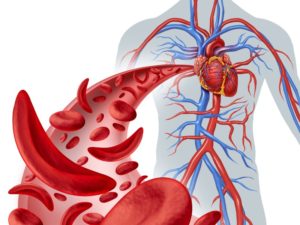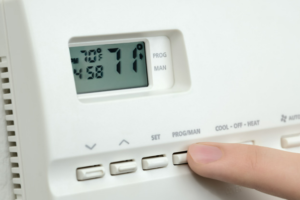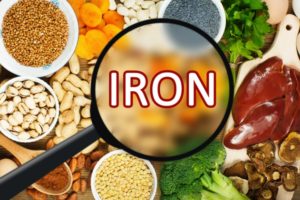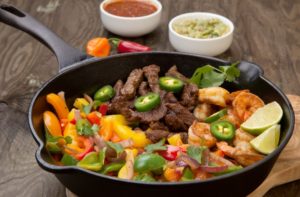 Do you ever wonder if you are getting enough iron?
Do you ever wonder if you are getting enough iron?
Have you been told you need to get more iron in your diet?
If so, you’re not alone.
We were doing a cooking demo a couple of weeks ago and one of the participants asked if there were specific things she could do to get more iron in her diet. Realizing that she is not the only one with this question, we decided it was time for a coaching tip!
Like so many things when it comes to food and your health, iron can be super-confusing. And like so many things when it comes to food and your health, it can be really simple and easy. You know where this is going…the best place to start is EAT A WIDE VARIETY OF REAL FOOD!
What is iron exactly?
 It’s no surprise to anyone that iron is critical for a fully functioning immune system. It is a major component of hemoglobin, which is a protein in red blood cells that carries oxygen from your lungs to all parts of your body. Iron is also a part of myoglobin, a protein that carries and stores oxygen in your muscle tissues.
It’s no surprise to anyone that iron is critical for a fully functioning immune system. It is a major component of hemoglobin, which is a protein in red blood cells that carries oxygen from your lungs to all parts of your body. Iron is also a part of myoglobin, a protein that carries and stores oxygen in your muscle tissues.
There are two types of iron that come from your food:
- Heme iron: this type is found in animal foods, including red meat, poultry and seafood. It is more easily absorbed by your body than non-heme iron.
- Non-heme iron: this type is found primarily in plant foods like whole grains, nuts, seeds, legumes, dark leafy greens, and a variety of vegetables. There is also a small amount of non-heme iron in meats (the amount depends on what the animals are eating). It can also be found in iron-fortified foods like some breads, cereals and infant formulas. It is not absorbed as efficiently as heme iron, although there are things you can do to increase absorption like including meat or Vitamin C with your meal (keep reading).
Your body is like a thermostat…
 Think about your thermostat in your house. If you set it at 71 degrees, it automatically regulates the temperature to keep it within a couple degrees of where you set it.
Think about your thermostat in your house. If you set it at 71 degrees, it automatically regulates the temperature to keep it within a couple degrees of where you set it.
Your body does the same thing with iron (primarily non-heme iron). You have a hormone that adjusts the absorption of iron from your digestive system, depending on whether you have too much or too little. If you have too much iron, it will decrease absorption. And if you have too little iron, it will increase absorption. Like your thermostat, your body generally does a good job regulating your iron absorption. Of course, you have to consume enough iron to allow it to work, and you have to avoid overloading your body with too much.
How much iron should you consume?
The recommended daily allowance is:
- 8 mg for men
- 18 mg for women who are menstruating (8 mg for women who are not)
- 27 mg for women who are pregnant
- Amounts vary for children based on age. From 14-18, when they are actively growing, recommendations are 11 mg for boys and 15 mg for girls.
- The tolerable upper intake level is 45 mg (or 40 mg for those under the age of 14).
What if you are not getting enough?
 If you aren’t getting enough iron, your blood may lack the healthy red blood cells needed to carry sufficient oxygen throughout your body. This can make you feel fatigued, weak or lightheaded. This condition is often referred to as iron deficiency anemia. There are many causes for iron deficiency including:
If you aren’t getting enough iron, your blood may lack the healthy red blood cells needed to carry sufficient oxygen throughout your body. This can make you feel fatigued, weak or lightheaded. This condition is often referred to as iron deficiency anemia. There are many causes for iron deficiency including:
- Not consuming enough iron in your diet
- Blood loss (including women who are menstruating heavily)
- Pregnancy (you are now nourishing two people, not just one)
- Increased needs for infants and children, including during growth spurts
- Celiac disease and other intestinal disorders can affect iron absorption
- Endurance athletes (women who are also menstruating can be especially at risk)
If you aren’t sure if your iron levels are sufficient, your doctor can help you check it out with a simple blood test that evaluates the number, size and shape of your red blood cells.
If you need to increase your iron levels, there are some things you can do!
 Eat a wide variety of REAL food. Even if you are vegetarian (or eating predominantly plants), you can easily get 8 mg or more through your food. Below, we provide a list of some foods that have a higher iron content. Also, including some meat or Vitamin C (ascorbic acid) with your meal will help your body better absorb the iron (high Vitamin C foods include oranges and other citrus, broccoli, brussels sprouts, cabbage, tomatoes, peppers, melon, berries and kiwi). Plus, good ole vinegar (because of its acidity) helps to enhance iron absorption – enjoy vinegar on your raw and cooked greens and everything in between (and here is a list of some of our favorite dressings, many of which contain vinegar).
Eat a wide variety of REAL food. Even if you are vegetarian (or eating predominantly plants), you can easily get 8 mg or more through your food. Below, we provide a list of some foods that have a higher iron content. Also, including some meat or Vitamin C (ascorbic acid) with your meal will help your body better absorb the iron (high Vitamin C foods include oranges and other citrus, broccoli, brussels sprouts, cabbage, tomatoes, peppers, melon, berries and kiwi). Plus, good ole vinegar (because of its acidity) helps to enhance iron absorption – enjoy vinegar on your raw and cooked greens and everything in between (and here is a list of some of our favorite dressings, many of which contain vinegar).- Use cast iron cookware. Studies have shown that regular use of cast iron cookware can increase the iron content of your food. The increase depends on the type of food (acidic foods with a high moisture content seem to do the best) and cooking time. Meals where the cast iron can go from the stove to the oven are great options (like the Chipotle Huevos Rancheros or the Middle Eastern Lamb Shakshuka).
- Consider a supplement. Especially for women who are pregnant, this can be important. Talk to your doctor because there are different types of iron supplements. And make sure you don’t go overboard.
Can you get too much?
Yes, too much of a good thing can turn it into a bad thing. Too much iron can act as a “pro-oxidant” and can cause damage to your organs and increase the risk of cancer and heart disease. Excessive iron levels can result from high-dose supplements or your body not regulating the levels appropriately (too much absorption).
What foods are good sources of iron?
As we said above, eating a wide variety of REAL FOOD will help you get an optimal level of iron. Some good sources include:
 Meat, poultry and seafood
Meat, poultry and seafood- Dark leafy greens like kale, spinach and Swiss chard
- Vegetables like mushrooms, beets, asparagus, potatoes, artichokes, tomatoes and bell peppers
- Beans and legumes, including lentils, cannellini beans, chickpeas, black beans, edamame,and peas
- Nuts and seeds, including pepitas, sesame seeds, cashews, chia seeds, flax seeds, peanuts, almonds and pistachios
- Whole grains, including farro, quinoa, oats and barley
- Dried fruits, including apricots, figs and raisins
- Soybean products, including tempeh and tofu
 Chocolate, including cacao powder, cacao nibs and dark chocolate with a high cacao percentage
Chocolate, including cacao powder, cacao nibs and dark chocolate with a high cacao percentage
If you or someone you know are struggling to get your iron levels within a healthy range, try these tips and see what happens.
And, as always, if you have a story or experience to share, please let us know!





Thank you so much for this article that applies to me personally right now. I had my iron level checked and it was at 12. I had two iron infusions and it increased to 265. Now I need to maintain it. I will definitely be trying out your tips!
Thank you for this information because I donate platelets monthly and it requires a hemoglobin level of 12.5. I donate to help others, but I also don’t want my donations to become a health concern for me. I started taking a multi vitamin with iron, but I think I will just try to accomplish my intake of real foods to continue to keep my hemoglobin levels within the healthy levels, so thank you.